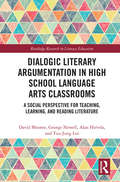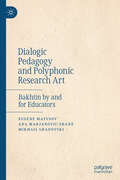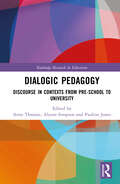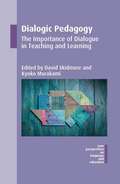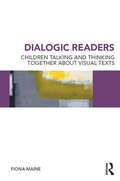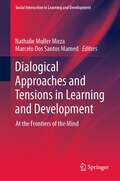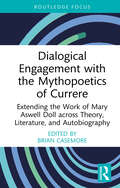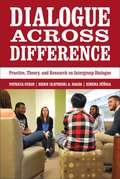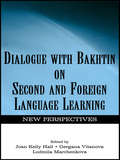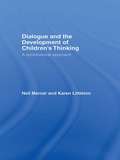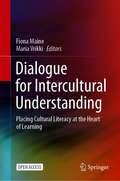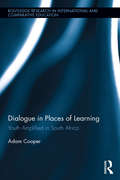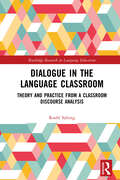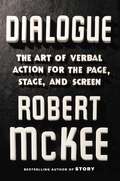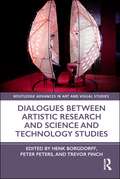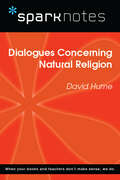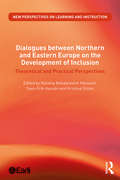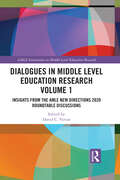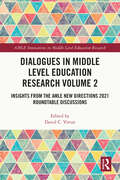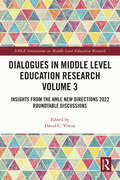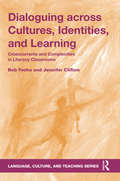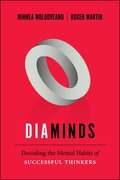- Table View
- List View
Dialogic Literary Argumentation in High School Language Arts Classrooms: A Social Perspective for Teaching, Learning, and Reading Literature (Routledge Research in Literacy Education)
by David Bloome George Newell Alan R Hirvela Tzu-Jung LinWritten by leaders in the field of literacy and language arts Education, this volume defines Dialogic Literary Argumentation, outlines its key principles, and provides in-depth analysis of classroom social practices and teacher-student interactions to illustrate the possibilities of a social perspective for a new vision of teaching, reading and understanding literature. Dialogic Literary Argumentation builds on the idea of arguing to learn to engage teachers and students in using literature to explore what it means to be human situated in the world at a particular time and place. Dialogic Literary Argumentation fosters deep and complex understandings of literature by engaging students in dialogical social practices that foster dialectical spaces, intertextuality, and an unpacking of taken-for-granted assumptions about rationality and personhood. Dialogic Literary Argumentation offers new ways to engage in argumentation aligned with new ways to read literature in the high school classroom. Offering theory and analysis to shape the future use of literature in secondary classrooms, this text will be great interest to researchers, graduate and postgraduate students, academics and libraries in the fields of English and Language Arts Education, Teacher Education, Literacy Studies, Writing and Composition.
Dialogic Pedagogy and Polyphonic Research Art: Bakhtin by and for Educators
by Ana Marjanovic-Shane Eugene Matusov Mikhail GradovskiThis book presents voices of educators describing their pedagogical practices inspired by the ethical ontological dialogism of Mikhail M. Bakhtin. It is a book of educational practitioners, by educational practitioners, and primarily for educational practitioners. The authors provide a dialogic analysis of teaching events in Bakhtin-inspired classrooms and emerging issues, including: prevailing educational relationships of power, desires to create a so-called educational vortex in which all students can experience ontological engagement, and struggles of innovative pedagogy in conventional educational institutions. Matusov, Marjanovic-Shane, and Gradovski define a dialogic research art, in which the original pedagogical dialogues are approached through continuing dialogues about the original issues, and where the researchers enter into them with their mind and heart.
Dialogic Pedagogy and Polyphonic Research Art: Bakhtin by and for Educators
by Ana Marjanovic-Shane Eugene Matusov Mikhail GradovskiThis book presents voices of educators describing their pedagogical practices inspired by the ethical ontological dialogism of Mikhail M. Bakhtin. It is a book of educational practitioners, by educational practitioners, and primarily for educational practitioners. The authors provide a dialogic analysis of teaching events in Bakhtin-inspired classrooms and emerging issues, including: prevailing educational relationships of power, desires to create a so-called educational vortex in which all students can experience ontological engagement, and struggles of innovative pedagogy in conventional educational institutions. Matusov, Marjanovic-Shane, and Gradovski define a dialogic research art, in which the original pedagogical dialogues are approached through continuing dialogues about the original issues, and where the researchers enter into them with their mind and heart.
Dialogic Pedagogy: Discourse in Contexts from Pre-school to University (Routledge Research in Education)
by Alyson Simpson Pauline Jones Anne ThwaiteTaking a dialogic approach, this edited book engages in analysis and description of dialogic discourse in a number of different educational contexts, from early childhood to tertiary, with an international team of contributors from Australia, Finland, New Zealand and the United Kingdom. The chapters focus mostly on dialogic face-to-face discourse, with some examples of online interactions, and feature insights from educational linguistics, particularly the work of Michael Halliday. While the contributors come from a range of theoretical backgrounds, they all share an interest in language in use and engage in close analysis of transcripts of naturally-occurring interaction. Taking inspiration from Alexander and other theorists, they employ a fine-grained and analytic approach to the exploration of their data. The authors make use of the linguistic tools and models of language in society, in order to examine the turn-by-turn unfolding of the interaction. The authors relate their insights from disparate forms of linguistic analysis to elements of Alexander’s (2020) dialogic framework, situating the discourse in its contexts and discussing the pedagogical implications of the linguistic choices at play. In presenting this work from a range of situations and perspectives, the authors strive to demonstrate how dialogic discourse plays out in educational contexts across the world. The book aims to foster further research in this direction and to inspire educators to explore dialogic discourse for themselves. It will be of interest to a wide audience, including literacy researchers, linguists, teachers and teacher educators, as well as graduate students.
Dialogic Pedagogy: The Importance of Dialogue in Teaching and Learning
by Kyoko Murakami David SkidmoreThis book provides a wide-ranging and in-depth theoretical perspective on dialogue in teaching. It explores the philosophy of dialogism as a social theory of language and explains its importance in teaching and learning. Departing from the more traditional teacher-led mode of teacher-student communication, the dialogic approach is more egalitarian and focuses on the discourse exchange between the parties. Authors explore connections between dialogic pedagogy and sociocultural learning theory, and argue that dialogic interaction between teacher and learners is vital if instruction is to lead to cognitive development. The book also presents prosody as a critical resource for understanding between teachers and students, and includes some of the first empirical studies of speech prosody in classroom discourse.
Dialogic Readers: Children talking and thinking together about visual texts
by Fiona MaineDialogic Readers: Children talking and thinking together about visual texts celebrates the sophisticated and dynamic discussions that primary-aged children can have as they talk together to make meaning from a variety of texts, and it highlights the potential for talk between readers as a tool for critical and creative thinking. It proposes a new dialogic theory of reading comprehension that incorporates multi-modal media and adds further weight to the argument that talk as a tool for learning should form a central part of primary classroom learning and teaching. The book explores: • the language of co-construction • children’s critical and creative responses to text • the dialogic transaction between text and readers • the use of language as a tool for creating a social cohesion between readers. This significant work is aimed at educational lecturers, researchers and students who want to explore an expanded notion of reading comprehension in the twenty-first century, realizing how opportunities for children thinking creatively together might transform the potential for learning in the classroom. It provides a framework for analyzing co-constructive talk with suggestions for promoting children’s critical and creative thinking.
Dialogic: Education For The Internet Age
by Rupert WegerifDialogic: Education for the Internet Age argues that despite rapid advances in communications technology, most teaching still relies on traditional approaches to education, built upon the logic of print, and dependent on the notion that there is a single true representation of reality. In practice, the use of the Internet disrupts this traditional logic of education by offering an experience of knowledge as participatory and multiple. This new logic of education is dialogic and characterises education as learning to learn, think and thrive in the context of working with multiple perspectives and ultimate uncertainty. The book builds upon the simple contrast between observing dialogue from an outside point of view, and participating in a dialogue from the inside, before pinpointing an essential feature of dialogic: the gap or difference between voices in dialogue which is understood as an irreducible source of meaning. Each chapter of the book applies this dialogic thinking to a specific challenge facing education, re-thinking the challenge and revealing a new theory of education. Areas covered in the book include: dialogical learning and cognition dialogical learning and emotional intelligence educational technology, dialogic ‘spaces’ and consciousness global dialogue and global citizenship dialogic theories of science and maths education The challenge identified in Wegerif’s text is the growing need to develop a new understanding of education that holds the potential to transform educational policy and pedagogy in order to meet the realities of the digital age. Dialogic: Education for the Internet Age draws upon the latest research in dialogic theory, creativity and technology, and is essential reading for advanced students and researchers in educational psychology, technology and policy.
Dialogical Approaches and Tensions in Learning and Development: At the Frontiers of the Mind (Social Interaction in Learning and Development)
by Nathalie Muller Mirza Marcelo Dos Santos MamedThe book pursues the goal of exploring and strengthening a dialogical approach of communication and cognition. It brings together contributions from world-leading researchers related to the dialogical approach in education and psychology. It presents, among others, the place of language and materiality in the development of communication and thinking, as well as the role of the methods in the relationship between researchers and participants. This leads to an innovative definition of the dialogicality and how a dialogical approach can provide heuristic (conceptual and methodological) tools to better understand how people think, communicate and learn in a complex world.The authors hereby develop an epistemological framework inspired by scholars such as Michaïl Bakhtin, Lev Vygotsky and Herbert Mead under the assumption that dialogue, or dialogicality - and therefore the presence of the other – is fundamentally entangled into the human thinking and development.This book contributes to the understanding of human communication, cognition and mind, and participates in a scientific dialogue which helps to advance future research. It includes theoretical and empirical chapters and presents innovative methods of inquiry, which makes it a useful tool for both teaching and research.
Dialogical Engagement with the Mythopoetics of Currere: Extending the Work of Mary Aswell Doll across Theory, Literature, and Autobiography (Studies in Curriculum Theory Series)
by Brian CasemoreThis volume showcases a series of chapters that elaborate on Mary Aswell Doll’s contributions to the field of curriculum theory through her examination of currere as a mythopoetics. By bringing Doll’s Jungian, autobiographical, and literary perspectives into conversation with emergent forms of subjective inquiry—including aesthetic concepts, ecological questions, and spiritual themes—the volume foregrounds the originality and significance of Doll’s book The Mythopoetics of Currere in particular, while simultaneously extending it and demonstrating its applications in various scholarly conversations. Leading scholars in the field of curriculum studies such as William F. Pinar and Molly Quinn demonstrate how they use Doll’s ideas as pedagogy, as theoretical framing for their work, and as the basis of their own study and self-exploration. A response essay from Doll herself concludes the text, bringing further thought and insight to the mythopoetic dimensions of currere. This text will benefit scholars, academics, and students in the fields of curriculum studies, curriculum theory, and the foundations of education more broadly. Teachers and teacher educators interested in the conceptualization of curriculum in humanities education will also benefit from this volume.
Dialogue Across Difference: Practice, Theory, and Research on Intergroup Dialogue
by Patricia Gurin Ximena Zuniga Biren Ratnesh NagdaDue to continuing immigration and increasing racial and ethnic inclusiveness, higher education institutions in the United States are likely to grow ever more diverse in the 21st century. This shift holds both promise and peril: Increased inter-ethnic contact could lead to a more fruitful learning environment that encourages collaboration. On the other hand, social identity and on-campus diversity remain hotly contested issues that often raise intergroup tensions and inhibit discussion. How can we help diverse students learn from each other and gain the competencies they will need in an increasingly multicultural America? Dialogue Across Difference synthesizes three years’ worth of research from an innovative field experiment focused on improving intergroup understanding, relationships and collaboration. The result is a fascinating study of the potential of intergroup dialogue to improve relations across race and gender. First developed in the late 1980s, intergroup dialogues bring together an equal number of students from two different groups – such as people of color and white people, or women and men – to share their perspectives and learn from each other. To test the possible impact of such courses and to develop a standard of best practice, the authors of Dialogue Across Difference incorporated various theories of social psychology, higher education, communication studies and social work to design and implement a uniform curriculum in nine universities across the country. Unlike most studies on intergroup dialogue, this project employed random assignment to enroll more than 1,450 students in experimental and control groups, including in 26 dialogue courses and control groups on race and gender each. Students admitted to the dialogue courses learned about racial and gender inequalities through readings, role-play activities and personal reflections. The authors tracked students’ progress using a mixed-method approach, including longitudinal surveys, content analyses of student papers, interviews of students, and videotapes of sessions. The results are heartening: Over the course of a term, students who participated in intergroup dialogues developed more insight into how members of other groups perceive the world. They also became more thoughtful about the structural underpinnings of inequality, increased their motivation to bridge differences and intergroup empathy, and placed a greater value on diversity and collaborative action. The authors also note that the effects of such courses were evident on nearly all measures. While students did report an initial increase in negative emotions – a possible indication of the difficulty of openly addressing race and gender – that effect was no longer present a year after the course. Overall, the results are remarkably consistent and point to an optimistic conclusion: intergroup dialogue is more than mere talk. It fosters productive communication about and across differences in the service of greater collaboration for equity and justice. Ambitious and timely, Dialogue Across Difference presents a persuasive practical, theoretical and empirical account of the benefits of intergroup dialogue. The data and research presented in this volume offer a useful model for improving relations among different groups not just in the college setting but in the United States as well.
Dialogue With Bakhtin on Second and Foreign Language Learning: New Perspectives
by Joan Kelly Hall Gergana Vitanova Ludmila MarchenkovaThis volume is the first to explore links between the Russian linguist Mikhail Bakhtin's theoretical insights about language and practical concerns with second and foreign language learning and teaching. Situated within a strong conceptual framework and drawing from a rich empirical base, it reflects recent scholarship in applied linguistics that has begun to move away from formalist views of language as universal, autonomous linguistic systems, and toward an understanding of language as dynamic collections of cultural resources. According to Bakhtin, the study of language is concerned with the dialogue existing between linguistic elements and the uses to which they are put in response to the conditions of the moment. Such a view of language has significant implications for current understandings of second- and foreign-language learning.The contributors draw on some of Bakhtin's more significant concepts, such as dialogue, utterance, heteroglossia, voice, and addressivity to examine real world contexts of language learning. The chapters address a range of contexts including elementary- and university-level English as a second language and foreign language classrooms and adult learning situations outside the formal classroom. The text is arranged in two parts. Part I, "Contexts of Language Learning and Teaching," contains seven chapters that report on investigations into specific contexts of language learning and teaching. The chapters in Part II, "Implications for Theory and Practice," present broader discussions on second and foreign language learning using Bakhtin's ideas as a springboard for thinking.This is a groundbreaking volume for scholars in applied linguistics, language education, and language studies with an interest in second and foreign language learning; for teacher educators; and for teachers of languages from elementary to university levels. It is highly relevant as a text for graduate-level courses in applied linguistics and second- and foreign-language education.
Dialogue and the Development of Children's Thinking: A Sociocultural Approach
by Neil Mercer Karen LittletonThis book draws on extensive research to provide a ground-breaking new account of the relationship between dialogue and children’s learning development. It closely relates the research findings to real-life classrooms, so that it is of practical value to teachers and students concerned that their children are offered the best possible learning opportunities. The authors provide a clear, accessible and well-illustrated case for the importance of dialogue in children's intellectual development and support this with a new and more educationally relevant version of socio-cultural theory, which explains the fascinating relationship between dialogues and learning. In educational terms, a sociocultural theory that relates social, cultural and historical processes, interpersonal communication and applied linguistics, is an ideal way of explaining how school experience helps children learn and develop. By using evidence of how the collective construction of knowledge is achieved and how engagement in dialogues shapes children's educational progress and intellectual development, the authors provide a text which is essential for educational researchers, postgraduate students of education and teachers, and is also of interest to many psychologists and applied linguists.
Dialogue for Intercultural Understanding: Placing Cultural Literacy at the Heart of Learning
by Fiona Maine Maria VrikkiThis open access book is a result of an extensive, ambitious and wide-ranging pan-European project focusing on the development of children and young people’s cultural literacy and what it means to be European in the 21st century prioritising intercultural dialogue and mutual understanding. The Horizon 2020 funded, 3-year DIalogue and Argumentation for cultural Literacy Learning (DIALLS) project included ten partners from countries in and around Europe with the aim to centralise co-constructive dialogue as a main cultural literacy value and to promote tolerance, empathy and inclusion. This is achieved through teaching children in schools from a young age to engage together in discussions where they may have differing viewpoints or perspectives, to enable a growing awareness of their own cultural identities, and those of others. Central to the project is children’s engagement with wordless picture books and films, which are used as stimuli for discussions around core cultural themes such as social responsibility, living together and sustainable development. In order to enable intercultural dialogue in action, the project developed an online platform as a tool for engagement across classes, and which this book elaborates on.The book explores themes underpinning this unique interdisciplinary project, drawing together scholars from cultural studies, civics education and linguistics, psychologists, socio-cultural literacy researchers, teacher educators and digital learning experts. Each chapter of the book explores a theme that is common to the project, and celebrates its interdisciplinarity by exploring these themes through different lenses.
Dialogue in Places of Learning: Youth Amplified in South Africa (Routledge Research in International and Comparative Education)
by Adam CooperShowing how youth from one of the poorest and most violent neighborhoods in Cape Town, South Africa, learn differently in three educational contexts— in classrooms, in a community hip hop crew, on a youth radio show—this book illuminates how South African schools, like schools elsewhere, subtly reproduce inequalities by sorting students into social hierarchies linked to assessments of their use of language. Highlighting the voices and perspectives of young South Africans, this case study of youth in the global South explores how language is linked to cultural mixing which occurred during colonialism and slavery and continues through patterns of global mobility. Dialogue in Places of Learning: Youth Amplified in South Africa demonstrates how language and learning are bound to space and place.
Dialogue in the Language Classroom: Theory and Practice from a Classroom Discourse Analysis (Routledge Research in Language Education)
by Roehl SybingBy providing a contemporary understanding of theories on classroom dialogue through a sociocultural lens, Sybing offers innovative ways to observe and foster more engaged interaction between teacher and student, particularly in language learning contexts. How teachers interact with students has a profound impact on learning outcomes and learner development yet remains a topic that requires more attention in language education. As research and practice in all education domains shift toward more dialogic approaches to the co-construction of knowledge, language education can also benefit from a more comprehensive approach to classroom dialogue that is relevant to interaction with language learners. This book provides a foundational understanding of theories of classroom dialogue relevant to language classroom contexts, which will guide an analysis of teacher–student interactions taken from observations of a language classroom in order to propose a framework for language classroom dialogue for theory and practice. Researchers and practitioners in language education will benefit from a comprehensive overview of discussion of and contemporary research in classroom interaction, sociocultural theory, and intercultural communication. This book offers useful guidance to scholars where such discussions are especially useful for addressing issues of native-speakerism and language ownership.
Dialogue: The Art of Verbal Action for Page, Stage, and Screen
by Robert MckeeThe long-awaited follow-up to the perennially bestselling writers' guide Story, from the most sought-after expert in the art of storytelling. Robert McKee's popular writing workshops have earned him an international reputation. The list of alumni with Oscars runs off the page. The cornerstone of his program is his singular book, Story, which has defined how we talk about the art of story creation. Now, in DIALOGUE, McKee offers the same in-depth analysis for how characters speak on the screen, on the stage, and on the page in believable and engaging ways. From Macbeth to Breaking Bad, McKee deconstructs key scenes to illustrate the strategies and techniques of dialogue. DIALOGUE applies a framework of incisive thinking to instruct the prospective writer on how to craft artful, impactful speech. Famous McKee alumni include Peter Jackson, Jane Campion, Geoffrey Rush, Paul Haggis, the writing team for Pixar, and many others.
Dialogues Between Artistic Research and Science and Technology Studies (Routledge Advances in Art and Visual Studies)
by Trevor Pinch Peter Peters Henk BorgdorffThis edited volume maps dialogues between science and technology studies research on the arts and the emerging field of artistic research. The main themes in the book are an advanced understanding of discursivity and reasoning in arts-based research, the methodological relevance of material practices and things, and innovative ways of connecting, staging, and publishing research in art and academia. This book touches on topics including studies of artistic practices; reflexive practitioners at the boundaries between the arts, science, and technology; non-propositional forms of reasoning; unconventional (arts-based) research methods and enhanced modes of presentation and publication.
Dialogues Concerning Natural Religion (SparkNotes Philosophy Guide)
by SparkNotesDialogues Concerning Natural Religion (SparkNotes Philosophy Guide) Making the reading experience fun! SparkNotes Philosophy Guides are one-stop guides to the great works of philosophy–masterpieces that stand at the foundations of Western thought. Inside each Philosophy Guide you&’ll find insightful overviews of great philosophical works of the Western world.
Dialogues between Northern and Eastern Europe on the Development of Inclusion: Theoretical and Practical Perspectives (New Perspectives on Learning and Instruction)
by Natallia Bahdanovich HanssenThe concepts of inclusion and inclusive education for children with special education needs (SEN) have been widely accepted as imperative undertakings in the education spectrum. This book posits the practice of these ideas by scrutinizing the methodologies adopted by varied nations of the two regions towards inclusive education along with juxtaposing the dichotomous observations to enable a dialogue regarding the actualization of inclusive education. The book looks at the distinct approaches taken by Northern and Eastern European education systems to realize inclusive education for children with SEN and aims to enable a space for dialogue wherein the reader would be able to access the cultural context of each practice, expand their cognizance regarding the concept of inclusivity and develop a more nuanced and sensitive approach to inclusive education. In the act of exploring the myriad ways in which inclusivity is practiced in the two regions, the book thusly provides insights into the pluralities and significance of inclusion in the education sector across a global spectrum. The anthology will be of interest to a vast range of audience, videlicet, individuals, students, researchers, professionals, et al., invested in the education sector, special needs education and pedagogy. It further proposes appeal for individuals interested in performing scientific research on the subject. The book practically aims to be of interest for any individual invested in the discipline of education, development of community and the topics pertaining to education for children with SEN.
Dialogues in Middle Level Education Research Volume 1: Insights from the AMLE New Directions 2020 Roundtable Discussions (AMLE Innovations in Middle Level Education Research)
by David C. VirtueMirroring the roundtable discussions conducted at the 2020 Association for Middle Level Education (AMLE) conference, this volume highlights the dialogic knowledge-building process critical to advancing middle level teaching and research. Launching the new AMLE Innovations in Middle Level Education Research series, this collection captures the synergetic dialogue that occurs during professional meetings by collating and centering five recent studies on topics such as mathematics achievement, personalized and project-based learning, and teacher collaboration. A companion essay and critical external response accompanies each study, serving to re-situate original research and reconsider findings in view of professional insights and external critique gained through discussion at AMLE 2020. Ultimately, these response essays foreground potential avenues for future research and alternative thinking, laying the groundwork for implementation of critical discussion in the classroom environment. This text will benefit researchers, doctoral students, and academics in the fields of middle level education, educational research, and specifically research methods in education. Those interested in teaching and learning, and adolescent development more broadly, will also benefit from this volume.
Dialogues in Middle Level Education Research Volume 2: Insights from the AMLE New Directions 2021 Roundtable Discussions (AMLE Innovations in Middle Level Education Research)
by David C. VirtueThis book echoes and enhances the generative, dialogic, knowledge-building process that took place at the AMLE 2021 conference, reflecting the way in which middle-level researchers work collaboratively and draw ideas and inspiration for their studies from prior research and accounts of practice, as well as their own experiences in the field. Each of the five sections features a recent study presented at the roundtable session at the 2021 AMLE conference, accompanied by two companion pieces offering different perspectives on the work. In the latter, the authors enrich and extend the original research by incorporating feedback from the conference session discussions, revisiting their findings and conclusions, considering alternative approaches to further research, and proposing new or clarified implications for practice. Addressing themes across theoretical frameworks and diversity of research design, and with topics ranging from music education to teacher agency and the productive struggle, the volume crucially presents and discusses recent innovations in the field with a view to prompting future research questions and deeper inquiry. As such, it will benefit researchers, doctoral students, and academics in the fields of middle level education, educational research, and specifically research methods in education. Those interested in teaching and learning, and adolescent development more broadly will also benefit from this volume.
Dialogues in Middle Level Education Research Volume 3: Insights from the AMLE New Directions 2022 Roundtable Discussions (AMLE Innovations in Middle Level Education Research)
by David C. VirtueThis insightful book presents and discusses the dialogues that took place in the New Directions in Middle Level Education Research session at the 2022 Association for Middle Level Education (AMLE) conference. Carefully crafted and expert-led chapters draw upon four recent studies that were published in Research in Middle Level Education Online, the research journal of AMLE, and which were featured in a roundtable discussion at the 2022 AMLE conference. Each section of the book includes one of the four studies accompanied by two companion pieces offering different perspectives on the work. In the companion essays, the original authors enrich and extend their research by incorporating feedback from the conference session discussions, revisiting their findings and conclusions, considering alternative approaches to further research, and proposing new or clarified implications for practice. The book also comprises contributions from middle level education experts, who offer responses to each study, offering perspectives, critiques, and commentaries. Reflecting the generative, dialogic, knowledge-building process that took place at the AMLE conference, it showcases the collaborative work of middle level researchers who draw ideas and inspiration for their studies from prior research and accounts of practice, as well as their own experiences in the field. This book is an excellent resource for researchers, doctoral students, and academics in the fields of middle level education, educational research, and research methods in education.
Dialoguing across Cultures, Identities, and Learning: Crosscurrents and Complexities in Literacy Classrooms (Language, Culture, and Teaching Series)
by Bob Fecho Jennifer CliftonDrawing on Dialogical Self Theory, this book presents a new framework for social and cultural identity construction in the literacy classroom, offering possibilities for how teachers might adjust their pedagogy to better support the range of cultural stances present in all classrooms. In the complex multicultural/multiethnic/multilingual contexts of learning in and out of school spaces today, students and teachers are constantly dialoguing across cultures, both internally and externally, and these cultures are in dialogue with each other. The authors unpack some of the complexity of culture and identity, what people do with culture and identity, and how people navigate multiple cultures and identities. Readers are invited to re-examine how they view different cultures and the roles these play in their lives, and to dialogue with the authors about cultures, learning, literacy, identity, and agency.
Diaminds
by Mihnea Moldoveanu Roger L. MartinWhat constitutes successful thinking in business? What are some of the techniques used by top business minds in order to solve problems and create value? Diaminds breaks new ground in addressing these questions.Mihnea Moldoveanu and Roger Martin, creators of the Integrative Thinking curriculum at the Rotman School of Management, draw upon case studies and interviews - as well as theories and models from cognitive psychology, epistemology, analytic philosophy, and semiotics - to offer a new conception of successful intelligence that is immediately applicable to business situations. The 'diamind' (or dialogical mind) is characterized by bi-stability (simultaneously holding opposite plans, models, courses of action in mind while retaining the ability to act), meliorism (increasing the logical depth and informational breadth of one's thinking processes), choicefulness (retaining the ability to choose among various representations of the world, the self and others) and polyphony (thinking about the way one formulates and solves a problem while at the same time thinking about the problem itself). End-of-chapter exercises encourage readers to examine and re-engineer their own thought and perception patterns to develop these qualities and cultivate their own 'diaminds.'
Diamond Willow
by Helen FrostIn a remote area of Alaska, twelve-year-old Willow helps her father with their sled dogs when she is not at school, wishing she were more popular, all the while unaware that the animals surrounding her carry the spirits of ancestors who care for her.
